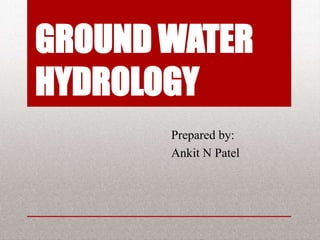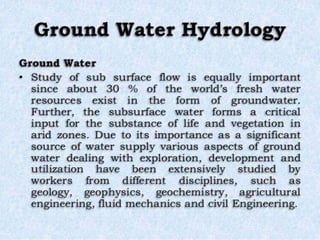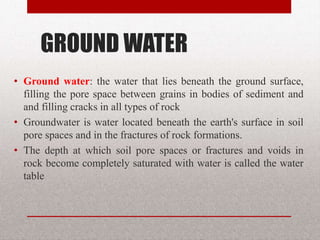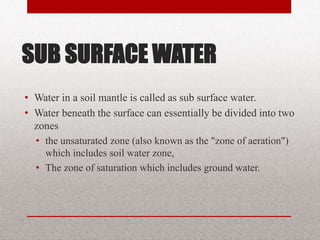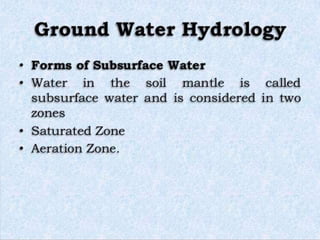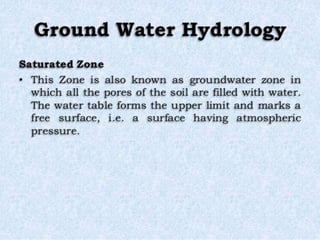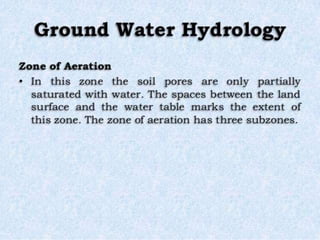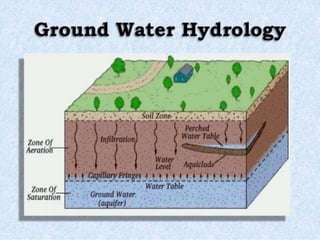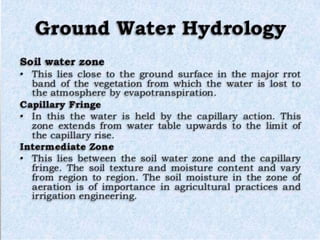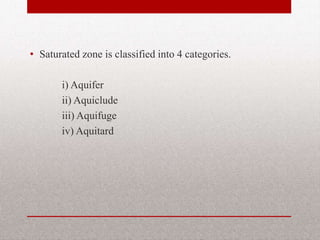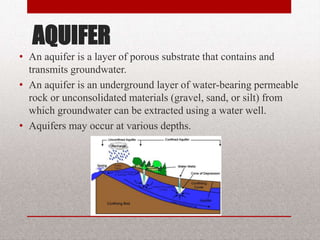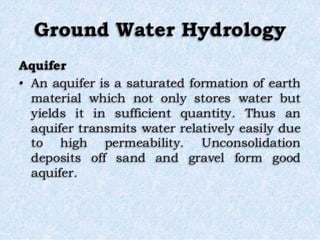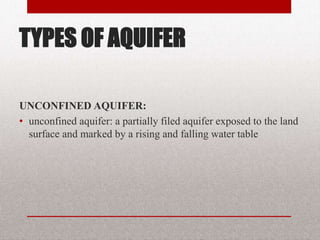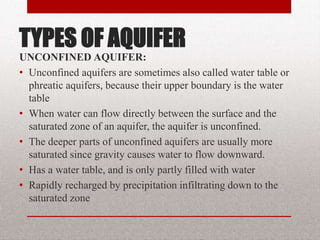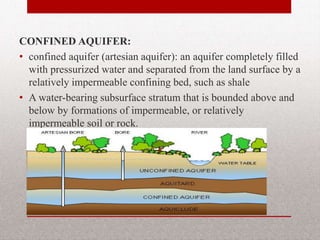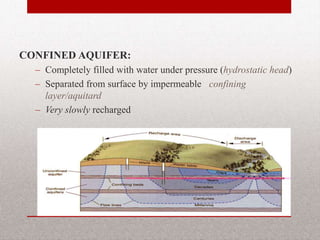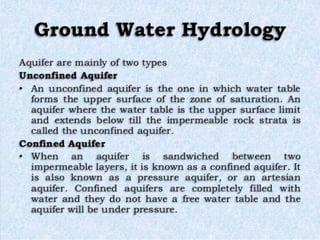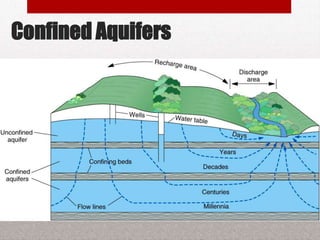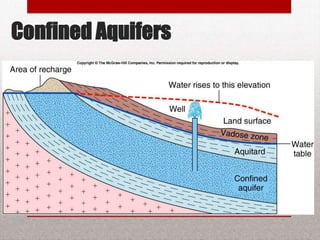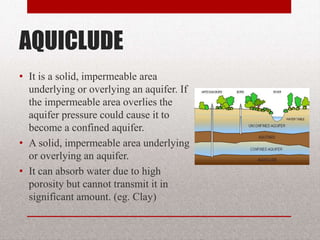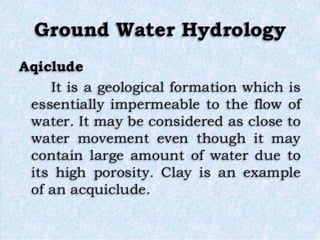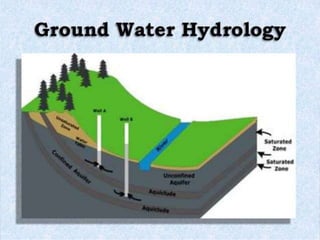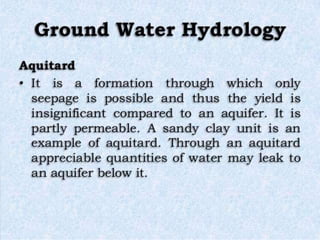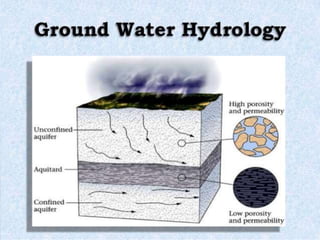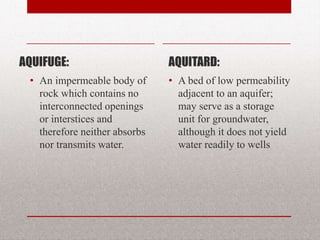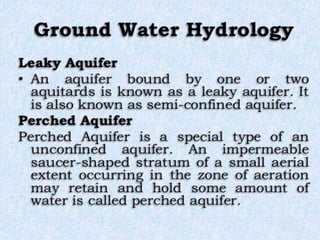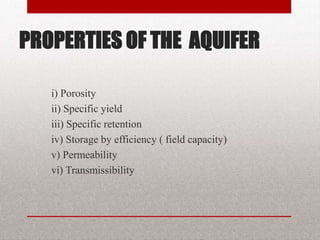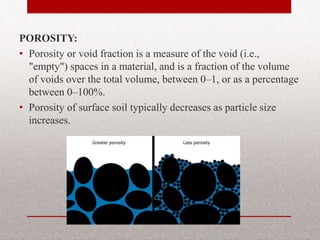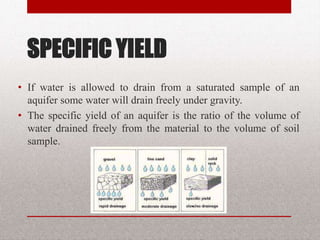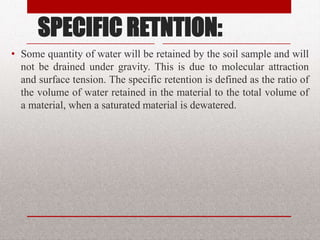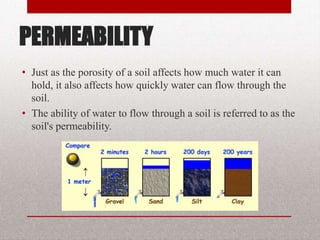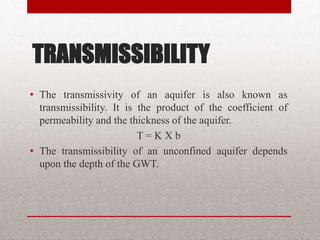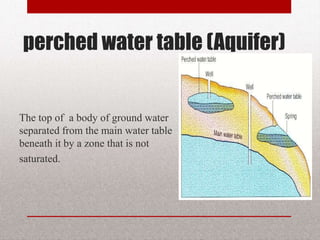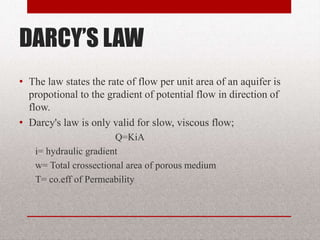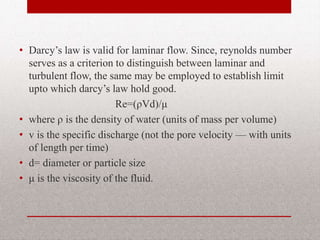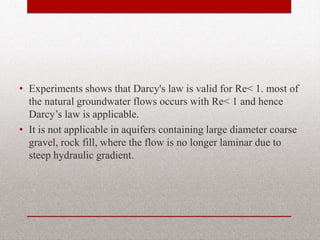Module 2 ch-2 ground water
- 1. GROUND WATER HYDROLOGY Prepared by: Prof. Ankit N Patel
- 2. BITS Edu Campus Prof. Ankit Patel 2
- 3. GROUND WATER • Ground water: the water that lies beneath the ground surface, filling the pore space between grains in bodies of sediment and and filling cracks in all types of rock • Groundwater is water located beneath the earth's surface in soil pore spaces and in the fractures of rock formations. • The depth at which soil pore spaces or fractures and voids in rock become completely saturated with water is called the water table BITS Edu Campus Prof. Ankit Patel 3
- 4. SUB SURFACE WATER • Water in a soil mantle is called as sub surface water. • Water beneath the surface can essentially be divided into two zones – the unsaturated zone (also known as the "zone of aeration") which includes soil water zone, – The zone of saturation which includes ground water. BITS Edu Campus Prof. Ankit Patel 4
- 5. BITS Edu Campus Prof. Ankit Patel 5
- 6. BITS Edu Campus Prof. Ankit Patel 6
- 7. BITS Edu Campus Prof. Ankit Patel 7
- 8. BITS Edu Campus Prof. Ankit Patel 8
- 9. BITS Edu Campus Prof. Ankit Patel 9
- 10. • Saturated zone is classified into 4 categories. i) Aquifer ii) Aquiclude iii) Aquifuge iv) Aquitard BITS Edu Campus Prof. Ankit Patel 10
- 11. AQUIFER • An aquifer is a layer of porous substrate that contains and transmits groundwater. • An aquifer is an underground layer of water-bearing permeable rock or unconsolidated materials (gravel, sand, or silt) from which groundwater can be extracted using a water well. • Aquifers may occur at various depths. BITS Edu Campus Prof. Ankit Patel 11
- 12. BITS Edu Campus Prof. Ankit Patel 12
- 13. TYPES OF AQUIFER UNCONFINED AQUIFER: • unconfined aquifer: a partially filed aquifer exposed to the land surface and marked by a rising and falling water table BITS Edu Campus Prof. Ankit Patel 13
- 14. TYPES OF AQUIFER UNCONFINED AQUIFER: • Unconfined aquifers are sometimes also called water table or phreatic aquifers, because their upper boundary is the water table • When water can flow directly between the surface and the saturated zone of an aquifer, the aquifer is unconfined. • The deeper parts of unconfined aquifers are usually more saturated since gravity causes water to flow downward. – Has a water table, and is only partly filled with water – Rapidly recharged by precipitation infiltrating down to the saturated zone BITS Edu Campus Prof. Ankit Patel 14
- 15. CONFINED AQUIFER: • confined aquifer (artesian aquifer): an aquifer completely filled with pressurized water and separated from the land surface by a relatively impermeable confining bed, such as shale • A water-bearing subsurface stratum that is bounded above and below by formations of impermeable, or relatively impermeable soil or rock. BITS Edu Campus Prof. Ankit Patel 15
- 16. CONFINED AQUIFER: – Completely filled with water under pressure (hydrostatic head) – Separated from surface by impermeable confining layer/aquitard – Very slowly recharged BITS Edu Campus Prof. Ankit Patel 16
- 17. BITS Edu Campus Prof. Ankit Patel 17
- 18. Confined Aquifers BITS Edu Campus Prof. Ankit Patel 18
- 19. Confined Aquifers BITS Edu Campus Prof. Ankit Patel 19
- 20. AQUICLUDE • It is a solid, impermeable area underlying or overlying an aquifer. If the impermeable area overlies the aquifer pressure could cause it to become a confined aquifer. • A solid, impermeable area underlying or overlying an aquifer. • It can absorb water due to high porosity but cannot transmit it in significant amount. (eg. Clay) BITS Edu Campus Prof. Ankit Patel 20
- 21. BITS Edu Campus Prof. Ankit Patel 21
- 22. BITS Edu Campus Prof. Ankit Patel 22
- 23. BITS Edu Campus Prof. Ankit Patel 23
- 24. BITS Edu Campus Prof. Ankit Patel 24
- 25. AQUIFUGE: • An impermeable body of rock which contains no interconnected openings or interstices and therefore neither absorbs nor transmits water. AQUITARD: • A bed of low permeability adjacent to an aquifer; may serve as a storage unit for groundwater, although it does not yield water readily to wells BITS Edu Campus Prof. Ankit Patel 25
- 26. BITS Edu Campus Prof. Ankit Patel 26
- 27. PROPERTIES OF THE AQUIFER i) Porosity ii) Specific yield iii) Specific retention iv) Storage by efficiency ( field capacity) v) Permeability vi) Transmissibility BITS Edu Campus Prof. Ankit Patel 27
- 28. POROSITY: • Porosity or void fraction is a measure of the void (i.e., "empty") spaces in a material, and is a fraction of the volume of voids over the total volume, between 0–1, or as a percentage between 0–100%. • Porosity of surface soil typically decreases as particle size increases. BITS Edu Campus Prof. Ankit Patel 28
- 29. SPECIFIC YIELD • If water is allowed to drain from a saturated sample of an aquifer some water will drain freely under gravity. • The specific yield of an aquifer is the ratio of the volume of water drained freely from the material to the volume of soil sample. BITS Edu Campus Prof. Ankit Patel 29
- 30. SPECIFIC RETNTION: • Some quantity of water will be retained by the soil sample and will not be drained under gravity. This is due to molecular attraction and surface tension. The specific retention is defined as the ratio of the volume of water retained in the material to the total volume of a material, when a saturated material is dewatered. BITS Edu Campus Prof. Ankit Patel 30
- 31. PERMEABILITY • Just as the porosity of a soil affects how much water it can hold, it also affects how quickly water can flow through the soil. • The ability of water to flow through a soil is referred to as the soil's permeability. BITS Edu Campus Prof. Ankit Patel 31
- 32. TRANSMISSIBILITY • The transmissivity of an aquifer is also known as transmissibility. It is the product of the coefficient of permeability and the thickness of the aquifer. T = K X b • The transmissibility of an unconfined aquifer depends upon the depth of the GWT. BITS Edu Campus Prof. Ankit Patel 32
- 33. perched water table (Aquifer) The top of a body of ground water separated from the main water table beneath it by a zone that is not saturated. BITS Edu Campus Prof. Ankit Patel 33
- 34. DARCY’S LAW • The law states the rate of flow per unit area of an aquifer is propotional to the gradient of potential flow in direction of flow. • Darcy's law is only valid for slow, viscous flow; Q=KiA i= hydraulic gradient w= Total crossectional area of porous medium T= co.eff of Permeability BITS Edu Campus Prof. Ankit Patel 34
- 35. • Darcy’s law is valid for laminar flow. Since, reynolds number serves as a criterion to distinguish between laminar and turbulent flow, the same may be employed to establish limit upto which darcy’s law hold good. Re=(ρVd)/μ • where ρ is the density of water (units of mass per volume) • v is the specific discharge (not the pore velocity — with units of length per time) • d= diameter or particle size • μ is the viscosity of the fluid. BITS Edu Campus Prof. Ankit Patel 35
- 36. • Experiments shows that Darcy's law is valid for Re< 1. most of the natural groundwater flows occurs with Re< 1 and hence Darcy’s law is applicable. • It is not applicable in aquifers containing large diameter coarse gravel, rock fill, where the flow is no longer laminar due to steep hydraulic gradient. BITS Edu Campus Prof. Ankit Patel 36
- 37. THANK YOU… BITS Edu Campus Prof. Ankit Patel 37

